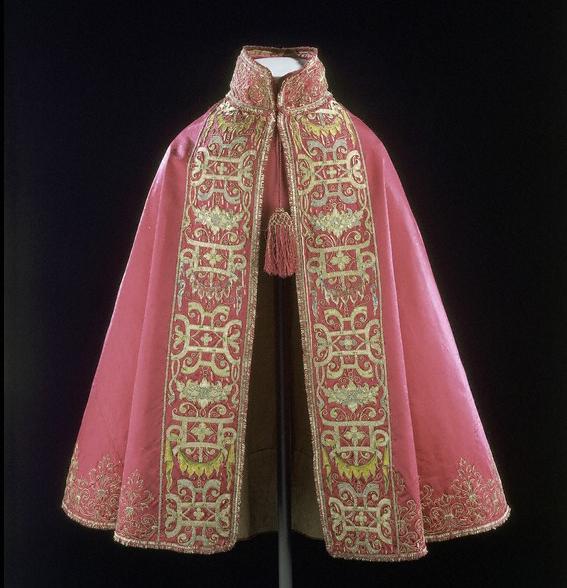English: Cloak, 1580-1600 V&A Museum no. 793-1901
Techniques -
Red satin, couched and embroidered with silver, silver-gilt and coloured silk threads, trimmed with silver-gilt and silk thread fringe and tassel, and lined with pink linen
Artist/designer -
Unknown
Place -
France
Dimensions -
Length 98.4 cm,
Width 196.9 cm (maximum)
Object Type -
A cloak was the third item of dress in a man's ensemble at the end of the 16th century. It was worn with a doublet and trunk hose. While most cloaks were used for protection, those made of expensive fabrics such as this silk were primarily symbols of wealth and social status.
Materials & Making -
Cloaks of the late 16th century were usually cut in the shape of a half, three-quarter or complete circle, depending on how much fabric the wearer could afford. The narrow width of the silk, about 56 centimetres, meant that the cloak was constructed of lengths of the fabric, hand sewn together and carefully pieced to avoid any waste.
The cost of the dye process was part of the expense of the silk. Red dyes were particularly expensive. This silk may have been coloured using cochineal, a dye obtained from an insect living on the Opuntia cactus that grew in the Spanish territories in Central America. By the end of the 16th century, cochineal was being cultivated and imported to Europe in great quantities.
Design & Designing -
The embroidery on the cloak is typical of the 1590s. In particular, the metal thread has been couched down in a pattern of interlaced bands known as strapwork. This style of decoration, imitating carved fretwork or bands of leather, originated in France in the 1530s and became popular throughout Northern Europe by the end of the 16th century.


